AMD at ISSCC 2015: Carrizo and Excavator Details
by Ian Cutress on February 23, 2015 7:45 PM EST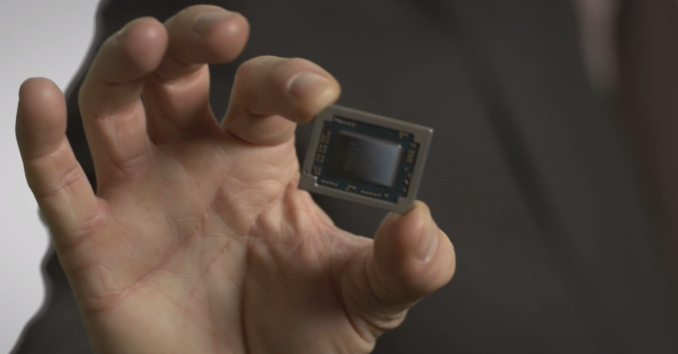
AMD is using the International Solid-State Circuits Conference this week to present a paper and announce some interesting developments regarding the next iteration of the Bulldozer architecture, codenamed ‘Excavator’, as well as other details regarding the CPU range that it will be placed in called ‘Carrizo’.
At the tail end of 2014 we reported on Carrizo and AMD’s announcement for its next generation of APUs, and more recently the discussion surrounding Carrizo not coming to desktop. In those announcements AMD revealed that Carrizo will be aimed at the laptop and notebook community first and foremost, a first for the company as previous APU designs have been aimed at both the desktop and mobile markets.
From a hardware standpoint, Carrizo will be combining a number of Excavator modules, AMD’s R-Series GCN GPUs, and the chipset/Fusion Controller Hub into a single package, bringing with it full HSA compatibility, TrueAudio, and ARM Trustzone compatibility. As with Kaveri before it, Carrizo will be built on Global Foundries’ 28nm Super High Performance (28SHP) node, making Carrizo a pure architecture upgrade without any manufacturing changes. Today’s ISSCC paper in turn builds on these revelations, showing some of the data from AMD’s internal silicon testing.
AMD’s presentation confirms that the new Excavator cores are low power optimized rather than desktop optimized. Support for Mantle and DirectX 12 should go without saying, and Dual Graphics support is something AMD has been working on for a number of generations. The next point is interesting from my perspective:
“Single-chip integration of the APU and the Southbridge onto a single die”
In our pre-briefing call, AMD confirmed that the Southbridge/FCH is no longer a separate chip, and is being moved on to the CPU from its previously separate package. In fact not only is the south bridge going to part of the CPU with Carrizo, but it's being fully integrated into the APU die itself. This is a first for AMD, and even Intel by comparison still uses two separate dies on the same package for their similar Broadwell-Y/U processors. As a result, AMD explained, this advances the Southbridge from the older 65nm/45nm processes to 28nm and 28SHP, reducing power consumption and operating voltage. It also allows the APU to accurately control power gating, further saving power, and reduces the length of HyperTransport interconnects between the APU and the I/O. On the flip side, it does move the soutb bridge's power consumption onto the APU, as well as the extra transistors it would otherwise occupy. This is explained in detail below.
The key element to Excavator’s design is a reduction in die area. Fundamentally everything is the same in terms of operation compared to Kaveri, but the internal units such as the FP scheduler and cache control have been re-engineered to take up less room on the same 28nm SHP process node. It seems a little odd applying a ‘high-density’ design to a ‘high-performance’ process node, but AMD is stating that part of this has been driven by the GPU team sharing its experiences and knowledge of small, efficient die components with the CPU team, allowing the lessons learned there to benefit AMD's CPU designs. This is combined with a "GPU-oriented" design stack on the CPU, which AMD is showing provides significant power savings at the same frequency, or higher frequency at the same power.
The high density, power optimized design also plays a role in the GPU segment of Carrizo, offering lower leakage at high voltages as well as allowing a full 8 GCN core design at 20W. This is an improvement from Kaveri, which due to power consumption only allowed a 6 GCN design at the same power without compromising performance.
AMD revealed Voltage Adaptive Operation back with Kaveri, and it makes a reappearance in Carrizo with its next iteration. The principle here is that with a high noise line, the excess voltage will cause power to rise. If the system reduces the frequency of the CPU during high noise/voltage segments - as power is proportional to voltage squared - power consumption will be reduced and then frequency can be restored when noise returns to normal. This happens inside the CPU over nanoseconds, resulting in no serious performance loss but it helps keep the power consumption of the APU down. In the case of Carrizo, AMD is quoting a 10-20% reduction in power consumption versus what a theoretical Carrizo would look like without this technology.
Another new addition to Excavator comes in the form of Adaptive Voltage-Frequency Scaling modules. Carrizo uses 10 in each Excavator ‘core’, and these modules can adjust the frequency and voltage of individual components depending on power requirements, temperature and other external factors in order to improve either performance, power consumption, or efficiency. With this in mind, AMD is claiming a 29% frequency increase at 10W, or if frequency is held constant then there is a 40-50% power decrease at the same 10W. At 20W, as the graph shows, there is almost no difference between the two, indicating that Excavator is truly built for lower TDP devices.
AMD is also presenting news on improvements to their ability to quickly enter and exit sleep states. With Excavator, AMD can now go from a sub-50mW S0i3 state to an active state in under a second. This should allow Carrizo devices to quickly reach and better sustain near-standby power levels, improving idle and low-load power consumption. As shown in the slide, at the S0i3 state only the ACP, PCH, and a small I/O segment are still active, while the rest of the device is completely power gated.
Meanwhile AMD is also once again showing off their technology timeline to illustrate their progress in implementing new technologies over the years. We confirmed that an interesting feature, inter-frame power gating, is active in Carrizo. This in a nutshell allows the GPU to go to a low frequency mode when the frame buffers are full. Though only a few milliseconds of power savings per instance, over time this can add up to larger increases battery life.
Wrapping up the hardware aspects of their ISSCC presentation, AMD is also disclosing the die size and transistor counts for Carrizo. Whereas Kaveri weighed in at 2.3 billion transistors in a 245mm2 die, Carrizo will come in at a much larger 3.1 billion transistors in a 250mm2 die. This a significant increase in transistor density for AMD, with Carrizo packing in 29% more transistors for only a marginal increase in die size. Though AMD is not explaining where all of the transistor increases come from at this time, part of the increase comes from the Southbridge/FCH being moved on-die, which AMD tells us will take up 5.5% of Carrizo's die. As for the Excavator cores themselves, AMD is starting that they consume 40% less power and take up 23% less die area, thanks to the combination of transistor density improvements, AVFS technology, and bringing the FCH on-die.
Moving on, although AMD's ISSCC presentation is not going to be diving deep into the Excavator architecture, AMD is claiming that Excavator will also bring with it a 5% IPC boost. We understand that this increase in IPC comes from a doubling of the L1 data cache from 64KB to 128KB, as well as further payoffs from the power improvements. Meanwhile on the fixed-function side of matters, Carrizo will be introducing a full H.265 hardware decoder. This is the first AMD part (CPU or GPU) to offer any kind of hardware support for H.265 decoding, and in the process it will be the first x86 CPU/APU to offer full hardware decode capabilities, as Intel still relies on a hybrid decode approach at this time.
Finally, AMD is also rolling out some new Heterogeneous System Architecture (HSA) functionality as part of Carrizo. HSA is seen as one of the next key factors in personal computing over the next decade. We have seen an almost ubiquitous shift in recent years towards almost every consumer processor having on-die graphics, and the ability to optimize a workload for each part of the system improves the experience. AMD has been riding this wave, announcing Kaveri as ‘HSA Ready’ and now Carrizo as ‘HSA Compliant’, fully adhering to HSA 1.0 specifications. At the moment the biggest benchmark showing off this power is PCMark, something AMD likes to promote. With regards the difference between HSA Ready and Compliant, I asked AMD what made Kaveri different in that regard. The answer was straightforward enough: Carrizo is able to perform GPU context switching, allowing a GPU state-save and state-restore, something Kaveri is unable to do and offering a solid hint that Carrizo's GPU is based on AMD's GCN 1.2 architecture.
Wrapping things up, the combination of a 5% IPC boost and 40% power savings means that AMD has a range of options for Carrizo parts, picking between increased clockspeeds at the same power levels or holding clockspeeds constant for a larger battery life gain. We expect that actual retail parts will be somewhere in the middle, as the graphs in the slides indicate that best efficiency occurs around the 10W scenario.
We did ask about absolute design numbers regarding battery life, processor frequencies and time to market. As expected, AMD is keeping its cards close to its chest, especially in a more academic environment such as ISSCC. At this point in time we were told that Carrizo is expected to come to market within Q2. With Computex taking place towards the end of Q2, this should mean that a number of Carrizo devices will either be on the market or at least on display for us to examine.


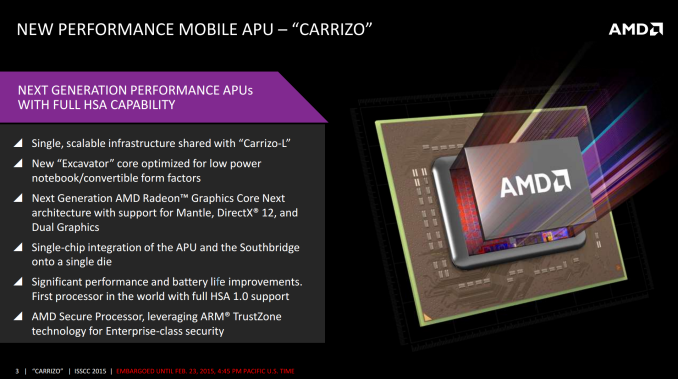
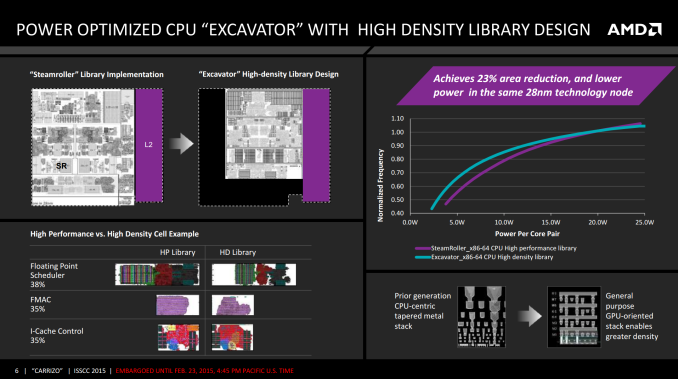

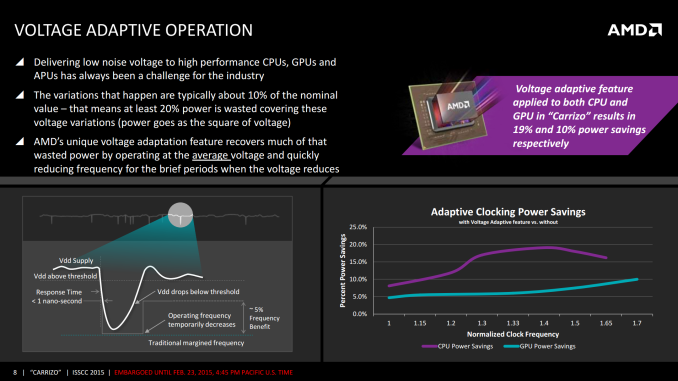
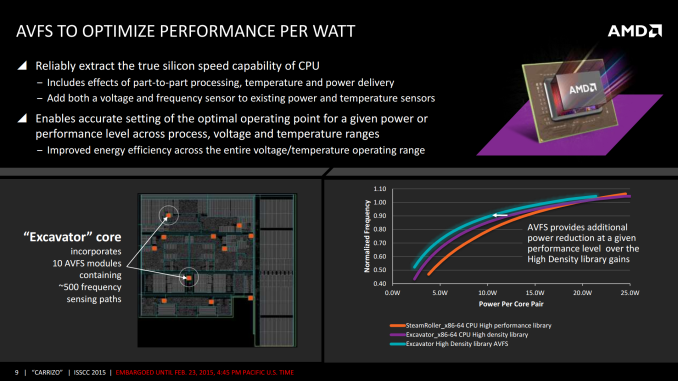
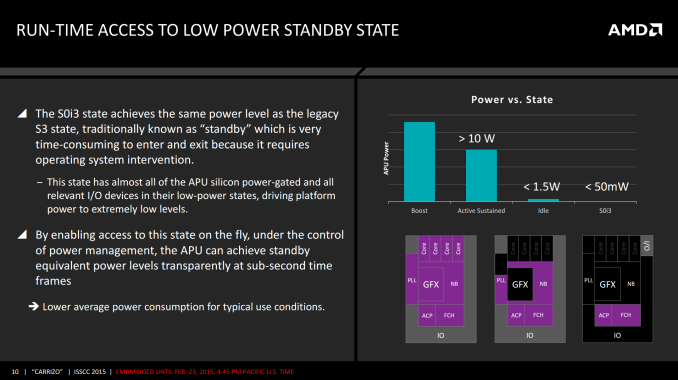
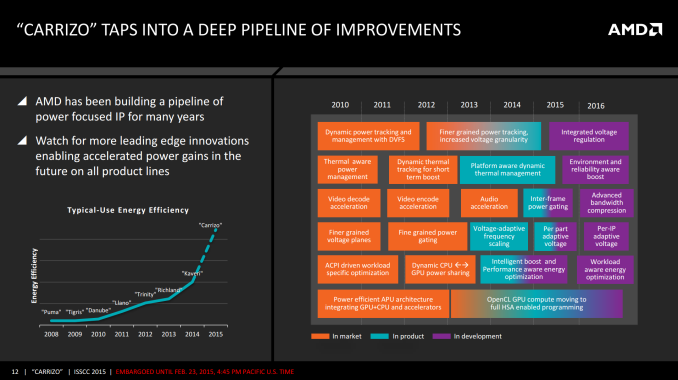

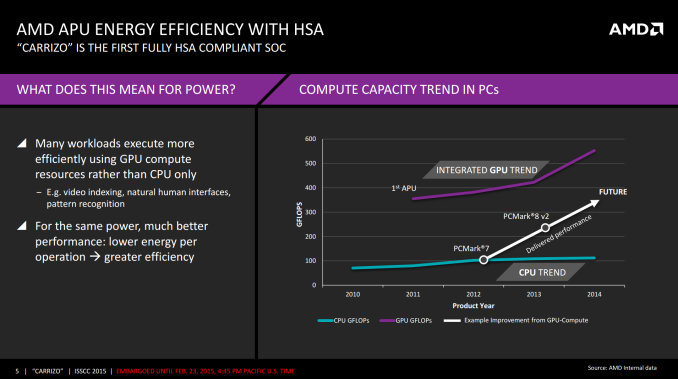








79 Comments
View All Comments
Achaios - Tuesday, February 24, 2015 - link
I didn't even read the OP. New CPU will have around the same single threaded performance with a Nehalem Intel CPU from 2008. I have lost faith that AMD will ever produce something even remotely antagonistic to Intel Sandy Bridge architecturefrom 2011, to say nothing of producing something that will give Haswell a run for its money. AMD will be on par with Haswell tech in around 2018-2019.firex123 - Tuesday, February 24, 2015 - link
Well, there's Zen coming up with a brand new architecture, with Jim Keller (of Athlon fame) back on board as chief architect.... who knows, AMD has something to catch up in 2016.yankeeDDL - Tuesday, February 24, 2015 - link
Kaveri is already competitive in terms of performance per Watt, compared to Sandy Bridge. With Carrizo it appears that they passed past Haswell and (almost) reached Broadwell.Pure performance is still behind, but it's good to see some competition again.
Plus, CPU performance is hardly an issue at these levels: unless you have extremely CPU-intensive tasks, you´ll be just fine with anything available on the market today. The good news is that the GPU now appears to seamlessly boost (some) CPU performance. Things are looking interesting!
yankeeDDL - Tuesday, February 24, 2015 - link
Is it me or this seems really exciting? At these power consumption you get fanless HTPC suitable for casual gaming in HD. Not bad, not bad at all.Now, if we can get 6 cores (3x modules) and 2X GPU for 50~60W on a desktop, that would be great.
pidgin - Tuesday, February 24, 2015 - link
Why do they keep making these? I've never seen AMD in laptops evername99 - Tuesday, February 24, 2015 - link
Oh for crying out loud. Go to Best Buy and check out the sub-$400 laptops. Half of them have an AMD chip in them.http://www.bestbuy.com/site/searchpage.jsp?st=AMD+...
Maybe you wouldn't buy such a laptop? Well, strange as it may seem, AMD is not in business to match your precise needs: you are not the star of anyone's movie except your own.
AMD have to make money where they can. Where they can is in providing this type of CPU to low-end laptops.
jabber - Wednesday, February 25, 2015 - link
AMD + Laptop = Junk.Thats where AMD are in the laptop market. The manufacturers thrown out a few crappy AMND based laptops purely to give the illusion of competition. Wouldn't surprise me if Intel pays for them.
TheJian - Tuesday, February 24, 2015 - link
AMD continues to chase crap that doesn't make money. Intel figured this out and goes high-end, then serves low if desired or have some fab space left, or at this point need to stop arm's advance up the chain (again this will squish amd margins). You go broke doing the opposite. NV figured it out with socs (avoided consoles, which crap on your CORE product R&D), and went high-end/auto until they can afford to do cheap volume to sell to people who can't afford high end models. NV also figured out they'll have a better mobile market once gaming gets amped up (so go auto until gaming is king and hardware used to max by those games), and they are required then (their gpu) and can get high margin customers easily who want GREAT gaming that replaced consoles etc. Why AMD is chasing poor people is beyond me. CHASE MONEY (rich) and you get profits and margins in the 55-64% range (check apple, not chasing poor). Chase the poor and you get ~35% margins. If you have debt, chasing poor just means you can afford the interest on your debt this year, but not much else. That is exactly what we see happening on their quarterly reports.This is a loser. All of these revs of this junk do nothing. This would be a good chip if Intel didn't exist, and ARM armada (all arm vendors) weren't coming up the chain. AMD should be announcing a 14nm GF CPU (with no gpu, I say GF because they have to use wafers still AFAIK, or go samsung if TSMC can't fix crap) that is total IPC monster to beat Intel and be paired with a top discrete chip for gamers delight. People I know who used to be staunch AMD supporters now don't even talk about them when discussing their next purchase. But we would switch instantly if they had a CPU monster sans gpu, that even matched intel for the same price. Most of us would be willing to even pay a tidbit more to support AMD, but would only do that for same or better perf. We no longer talk AMD because perf just sucks on cpu and we ALL disable the gpu on any of these.
Intel isn't selling a chip without gpu to enthusiast mainstream today, so all that gpu room AMD could be using for a IPC monster that could be priced above Intel's $350 range or at least equal pricing and beating their cpu perf. Most of the people that pay that have ZERO interest in that wasted gpu space Intel foists on us. You could sell a lot of HIGH MARGIN stuff with a chip that beats Intel handily in cpu and comes with no wasted gpu. The last time AMD made real MONEY was with a MONSTER CPU that had no gpu ;) Intel's HIGH end stuff is what allows them to make 13Billion which in turn allows stupid stuff like throwing away 4.1B+ on giving away mobile chips (instead of just buying NV and putting out a real soc to compete with arm but on a better process). A few more years losing 4B+ a year on mobile and Intel could have had NV for FREE...LOL. Management doesn't seem to get that point or can't get NV to sell.
Either way, AMD needs to chase MONEY, not broke people (meaning people who can't afford a laptop with a discrete gpu etc). Their current road just guards what they have that loses money. They need to take something ELSE that MAKES money. 28nm bare better than last year that uses less power does nothing vs. Intel who has better R&D by MILES and a die shrink on top. Are you trying to be the same NOTHING company, or finally make 1B+ profits again?
AMD has some great CPU architects back now, so why are they chasing parts that will be squeezed by ARM-->Intel racing to each other instead of chasing Intel top end without a gpu so you can BEAT their cpu and charge accordingly, which in turn means finally having some pricing power and a PROFIT for the whole YEAR. They are chasing a market that will be eaten by the ARM-Intel war. The perfect move is jumping ABOVE Intel in a shocker, while they're distracted by the race down to ARM all the while making enthusiasts blab about you at the water cooler again. In a DOWN PC sales market NV has thrived, while being able to throw away money on 5 fake socs until they could get discrete gpus into them and gaming catches up to use them (hence auto detour - where nobody is king yet). AMD should do PURE cpu IPC now and THEN come for cheaper stuff after milking the enthusiast cow (you know, titan buyers, 980/970, i7's etc - these people PAY).
I'm all for good deals and such as a consumer, but let some other sucker make those if they can afford low margin junk (Intel, ARM side etc). AMD needs to give me a reason to buy their chip AND their stock again. This is NOT how you do either. All this APU crap is stealing from core GPU tech too (obliterated by maxwell). Go back to Straight cpu/gpu company. I WANT to buy those, but I can't. I'm forced to go NV for gpu, and Intel for cpu unless I'm broke (which I'm not). I'm an AMD fan (their workers, older products etc), but management HATER for years. That group doesn't get it. Chase the rich so you can afford to do some poor stuff at some point which with high enough volume maybe makes you some change (but they won't win volume from Intel in APU who can just price those to death currently, especially with ARM coming up from bottom end). Chase the poor first however, and you just go broke with no margins. There is a reason NV launches 980/970 first (same with AMD in this case 290/290x) then deals lower end for poor consumers later. There is a reason NV said they won't chase commodity $200 phones for now and will concentrate on high-end phones and tablets or Autos. NV said they wouldn't do consoles due to margins (how's that working out for AMD). Learn AMD, LEARN! And quickly!
jabber - Wednesday, February 25, 2015 - link
If AMD want to see quality AMD based products on shelves then they have only one option.Make it themselves.
Just drop all the crappy E1 CPU junk! Real CPU/GPU/APU/RAM/SSD/IPS quality gear please.
sascha - Wednesday, February 25, 2015 - link
Nice but I hope FM2+ will see a proper update as well before 2016.http://www.kitguru.net/components/cpu/anton-shilov...